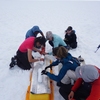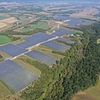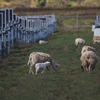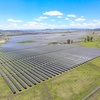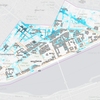Air & Climate
Introduction
Global climate change is having myriad negative impacts throughout the world, including increased frequency and potency of extreme weather events, sea level rise, species extinction, water shortages, declining agricultural production, and spread of diseases. The impacts are particularly pronounced for low-income communities and countries. In addition, institutions that inventory and take steps to reduce their air pollutant emissions can positively impact the health of the campus community, as well as the health of their local communities and regions.
Featured Resources
Latest News from AASHE Bulletin
New Resources
Solve Climate Worldwide Teach-in / 3.30.22 / Engage 1 Million Students
- Bard College (NY)
- AASHE (MA)
Another summer of record-breaking heatwaves, droughts, fires and floods has shown us how fast climate change impacts are hitting. As educators, there is nothing more important than engaging students across …
- Posted Nov. 3, 2021
- Videos & Webinars
- View more
Climate Action Plan
- University of Central Florida (FL)
In order of magnitude, UCF's main sources of emissions are: buildings, transportation, waste, and natural resources management. The long-term plan to lessen the university's environmental footprint focuses of these key …
- Posted Oct. 6, 2021
- Publications
- View more
Climate Action Plan Update
- New Mexico State University (NM)
The American College & University Presidents’ Climate Commitment (ACUPCC) is a highvisibility effort to address global climate disruption undertaken by a network of colleges and universities that have made institutional …
- Posted Oct. 6, 2021
- Publications
- View more
Climate Action Plan
- Seattle University (WA)
This Climate Action Plan (CAP) is intended to guide Seattle University in furthering its commitment to sustainability and to addressing climate change. The university envisions a campus community in which …
- Posted Oct. 6, 2021
- Publications
- View more
Climate Action Plan
- Portland State University (OR)
At the start of the CAP planning process, the Campus Sustainability Office (CSO) took a leadership role in drafting the Plan, including gathering data, setting goals and targets, and identifying …
- Posted Oct. 6, 2021
- Publications
- View more
Climate Action Plan
- University of California San Diego (CA)
In 2008, UC San Diego developed its first campus Climate Action Plan (CAP) for implementing the University’s climate strategy to meet State and UC climate policies and objectives. Specifically, the …
- Posted Oct. 6, 2021
- Publications
- View more
Climate Action Plan
- Carleton College (MN)
Carleton’s Climate Action Plan presents a practical approach that reflects Carleton’s current planning environment, ranging from the good fortune of our upcoming alumnisponsored wind turbine to realistic challenges such as …
- Posted Oct. 6, 2021
- Publications
- View more
Climate Action Vision 2019
- Barnard College (NY)
This vision is the product of a collaborative, communitywide effort. During the 2017-2018 academic year, the College hosted a “Campus Conversation” workshop series in which faculty, staff, and students worked …
- Posted Oct. 6, 2021
- Publications
- View more
Climate Action Plan
- Binghamton University (NY)
In September 2007, President Lois B. DeFleur signed the American College and University Presidents Climate Commitment (ACUPCC), pledging to eliminate, over time, the greenhouse gas emissions associated with Binghamton University’s …
- Posted Oct. 6, 2021
- Publications
- View more
Climate Action Plan
- California State University, Long Beach (CA)
The Climate Action Plan—developed by dedicated faculty, students and staff on our Sustainability Task Force—outlines ambitious strategies to achieve the kind of reductions needed to meaningfully address the climate crisis. …
- Posted Oct. 6, 2021
- Publications
- View more
Carbon neutrality should not be the end goal: Lessons for institutional climate action from U.S. higher education
- Hamilton College-Clinton.NY (NY)
- Smith College (MA)
- Ceres (MA)
Climate action pledges have increasingly taken the form of commitments to net carbon neutrality. Higher education institutions (HEIs) are uniquely positioned to innovate in this area, and over 800 United …
- Posted Oct. 6, 2021
- Publications
- View more
Academics, Equity, and Resilience: Building Pitt’s First Climate Action Plan
- University of Pittsburgh (PA)
- AASHE (MA)
- Baumgartner Urban Strategy Solutions (PA)
The University of Pittsburgh’s sustainability journey has been expounding over three decades, including the first university-wide Pitt Sustainability Plan (2018) and first AASHE STARS designation (Silver 2018); in 2021, Pitt …
- Posted Oct. 1, 2021
- Videos & Webinars
- View more
Calvin Energy Recovery Fund (CERF)
- Calvin University (MI)
The Calvin Energy Recovery Fund (CERF) is a revolving fund used to improve energy efficiency and reduce carbon dioxide emissions on campus. Plus, the cost savings from CERF projects are …
- Posted Sept. 21, 2021
- Green Funds
- View more
Sustainability Action Fund
- University of Guelph (ON)
The Sustainability Action Fund seeks to fund projects which advance campus sustainability and climate action at the University of Guelph. All student contributions are matched dollar for dollar by the …
- Posted Sept. 21, 2021
- Green Funds
- View more
Sustainability Scholars Fund
- Kenyon College (OH)
The Sustainability Scholars Fund exists to provide material and financial support for a student/faculty team conducting sustainability/climate action work on campus. Projects range from refining our understanding of landscape-level carbon-sequestration …
- Posted Sept. 21, 2021
- Green Funds
- View more
The Albert Sherman Center at UMass Chan Medical School
- UMass Chan Medical School (MA)
The Albert Sherman Center, a nine story 512,000 square-foot research and education building at UMass Chan Medical School, is certified LEED Gold.
- Posted Sept. 15, 2021
- Photographs
- View more
State-of-the-art mechanical systems at UMass Chan Medical School
- UMass Chan Medical School (MA)
Efficient mechanical systems at UMass Chan Medical School including chilled beams and energy recovery wheels.
- Posted Sept. 15, 2021
- Photographs
- View more
Principia College students routinely participate in multidisciplinary internships that challenge them to develop solutions to complex problems, such as modern climate change.
- Principia College (IL)
Abby Holt (in the red shirt), a double major in sustainability and geology at Principia College, has a passion for glaciology and the nexus between historically frozen landscapes and a …
- Posted Sept. 8, 2021
- Photographs
- View more
Bates College students install solar on their coastal research facility.
- Bates College (ME)
Bates College students install solar on their coastal research facility. This facility is now 100% solar thanks to the work of the students.
- Posted Sept. 8, 2021
- Photographs
- View more
The George Mason University Arboretum
- George Mason University (VA)
The George Mason University Arboretum cultivates curiosity, education, and well-being through stewardship of its trees, gardens, and other natural spaces. It was established in 2015, earned ArbNet Level II accreditation …
- Posted Sept. 8, 2021
- Photographs
- View more
SCI 2021: University of Utah Geothermal Contract
- University of Utah (UT)
Long-Term 20 MW Geothermal Power Purchase and Rate Tariff Leadership: The long-term 20 MW Geothermal Power Purchase and Rate Tariff Leadership project began supplying the University of Utah with 20 …
- Posted Aug. 30, 2021
- Photographs
- View more
EV Affordability and Charging Accessibility
- University of California San Diego (CA)
University of California, San Diego is advancing electric vehicle charging research, development and demonstration opportunities. Current projects include Adaptive Load Management, Vehicle-2-Grid, PV-Energy Storage integrated DC Fast Chargers, ISO 15118 …
- Posted Aug. 25, 2021
- Photographs
- View more
Lightsource bp Module Installation
- Pennsylvania State University (PA)
70-MW Solar Power Purchase Agreement - Pennsylvania State University partnered with solar developer Lightsource bp on a 70-megawatt, off-site solar energy project to supply about 25% of the University's electricity …
- Posted Aug. 23, 2021
- Photographs
- View more
Nittany 3 Solar Farm - Southern View
- Pennsylvania State University (PA)
70-MW Solar Power Purchase Agreement - Pennsylvania State University partnered with solar developer Lightsource bp on a 70-megawatt, off-site solar energy project to supply about 25% of the University's electricity …
- Posted Aug. 23, 2021
- Photographs
- View more
Nittany 3 Solar Farm
- Pennsylvania State University (PA)
70-MW Solar Power Purchase Agreement - Pennsylvania State University partnered with solar developer Lightsource bp on a 70-megawatt, off-site solar energy project to supply about 25% of the University's electricity …
- Posted Aug. 23, 2021
- Photographs
- View more
Nittany 1 Solar Farm
- Pennsylvania State University (PA)
70-MW Solar Power Purchase Agreement - Pennsylvania State University partnered with solar developer Lightsource bp on a 70-megawatt, off-site solar energy project to supply about 25% of the University's electricity …
- Posted Aug. 23, 2021
- Photographs
- View more
UQ 64MW Warwick Solar Farm, Grazing residential sheep
- University of Queensland (QLD)
Sheep grazing and tending the grounds at the University of Queensland's own 64 MW Warwick Solar Farm.
- Posted Aug. 19, 2021
- Photographs
- View more
UQ 64MW Warwick Solar Farm, Relief from the rain
- University of Queensland (QLD)
The University of Queensland's own residential sheep taking shelter from the rain at the 64MW solar farm. They are on a break from maintenance tasks where they mow and weed …
- Posted Aug. 19, 2021
- Photographs
- View more
UQ Warwick Solar Farm
- University of Queensland (QLD)
Aerial view of the University of Queensland's own 64 megawatt Warwick Solar Farm. The wholly university owned farm is powering UQ to be 100% renewable.
- Posted Aug. 19, 2021
- Photographs
- View more
Climate Solutions 101
- Project Drawdown (CA)
Climate Solutions 101 is a series of six short (10- to 30-minute) videos that not only explain the challenge of climate change but also introduce Project Drawdown's signature set of …
- Posted Aug. 17, 2021
- Course Materials
- View more
Dickinson College Achieves Carbon Neutrality
- Dickinson College (PA)
Carbon Neutral 2020 - Dickinson College attained carbon neutrality in 2020, reaching a goal that was established in 2007. Dickinson reduced GHG emissions by increasing energy efficiency of the campus, …
- Posted Aug. 11, 2021
- Photographs
- View more
Working with Vulnerable Communities on Climate Action through Nonformal Higher Education and Peacebuilding
- Salisbury University (MD)
- University of Cambridge
- M.K. Gandhi Institute for Nonviolence (NY)
Nonformal higher education provides an avenue to bypass the rigidity of hierarchical structures and prescribed norms within formal education, which offers opportunities to assist marginalized communities with climate action through …
- Posted July 7, 2021
- Videos & Webinars
- View more
Climate Friendly Cooling Pledge and New Regulations Affecting Universities: Opportunities and Implications
- Bard College (NY)
- Yale University (CT)
- AASHE (MA)
- Project Drawdown (CA)
- The Institute for Governance and Sustainable Development (DC)
Action is needed now by college staff in facilities, EHS, sustainability, student life, business offices, auxiliary services, housing, dining, planning, and procurement. Changes within all these staff areas to manage …
- Posted June 3, 2021
- Videos & Webinars
- View more
Embodied, operation, and commuting emissions: A case study comparing the carbon hotspots of an educational building
- State University of New York College of Environmental Science and Forestry (NY)
- University of Florida (FL)
- University of Vaasa
- Jilin University
Building operational energy, mobility energy, and materials embodied energy contribute to a significant portion of the global greenhouse gas emissions. Buildings stand at the intersection of these three contributors and, …
- Posted May 26, 2021
- Publications
- View more
CGHE 2020 Annual Conference webinar panel: Higher education and sustainability
- University of Bristol
- University College London (London)
- International Association of Universities
Higher education institutions both impact and are impacted by global climate change and the environment. In this conference hosted by the Centre for Global Higher Education, a panel of professors …
- Posted May 26, 2021
- Videos & Webinars
- View more
Managing Organizational Change For Transformational, Deep Decarbonization Initiatives On Campus
- Second Nature (MA)
From website: "This webinar examined the importance of managing cultural and process change to support the implementation of deep decarbonization initiatives on campus - focusing on the critical roles of …
- Posted May 26, 2021
- Videos & Webinars
- View more
CALPIRG Students Break Free From Plastics campaign
- California Student Public Interest Research Group (CA)
The CALPIRG Students Break Free From Plastics campaign aimed to address the problem of plastic pollution at the source by phasing out single-use plastic items both at our university campuses …
- Posted May 26, 2021
- Case Studies
- View more
International Climate Engagement
- Swarthmore College (PA)
Project Name: International Climate Engagement Name: Alfi Muhamad Project Mentor: Carr Everbach Faculty Advisor: Carol Nackenoff Project board members: Joy Charlton, Melissa Tier, Kyle Richmond-Crosset, Elizabeth Drake, Clare Hyre, …
- Posted May 26, 2021
- Case Studies
- View more
Brown University's Thermal Efficiency Project-2
- Brown University (RI)
Brown University is a 6.5 million sq. ft. research university campus founded in 1764 in Providence, Rhode Island. Its annual energy bill is $20 million. It serves 7,000 undergraduate students, …
- Posted May 26, 2021
- Case Studies
- View more
Incorporating Social Equity and Climate Justice into Climate Action Planning in Higher Education
- Portland Community College (OR)
Portland Community College’s 2021 Climate Action Plan: Resiliency, Equity and Education for a Just Transition (the CAP) centers people at the heart of creating benefits and solutions to the climate …
- Posted May 26, 2021
- Case Studies
- View more
MaryPIRG Student Climate Action Coalition (MSCAC)
- University of Maryland, College Park (MD)
The FUTURE Act is a piece of legislation which aims to commit all of Maryland’s Public Universities to carbon neutrality by 2035 or sooner. The legislation was introduced by Del …
- Posted May 26, 2021
- Case Studies
- View more
President's Sustainability Research Fellowship 20-21: Climate Community
- Swarthmore College (PA)
The 2020-2021 President's Sustainability Research Fellowship Climate Community project was conducted by Martin Tomlinson '23 and Maya Tipton '23 over the 2020-2021 Academic Year. The purpose of Climate Community was …
- Posted May 26, 2021
- Case Studies
- View more
President's Sustainability Research Fellowship 20-21: Carbon Offsets
- Swarthmore College (PA)
The 2020-2021 President's Sustainability Research Fellowship Carbon Offsets project was conducted by Olivia Stoetzer '23 over the 2020-2021 Academic Year. The purpose of the project was to help Swarthmore create …
- Posted May 26, 2021
- Case Studies
- View more
Reducing Scope Three Carbon Emissions Through Behavior Change & Menu Labeling
- University of California, Berkeley (CA)
In October 2020, UC Berkeley’s Cal Dining implemented carbon emission labels to better inform customers about the carbon impact of the recipes served in the dining hall. Student researchers, Alejandra …
- Posted May 25, 2021
- Case Studies
- View more
Mitigating Carbon Emissions While Staying In Business: A Case Study of Longview Farm
- Smith College (MA)
Smith College has aggressive goals for greenhouse gas emissions reduction and local food procurement. In an effort to understand supply chain emissions associated with food, students in the Environmental Science …
- Posted May 21, 2021
- Publications
- View more
Implications of Massachusetts Climate Policy for Smith College
- Smith College (MA)
Smith College has pledged to achieve carbon neutrality by 2030. To meet this goal, Smith is considering transitioning its district energy system from steam heat generated with natural gas to …
- Posted May 21, 2021
- Publications
- View more
MIT Climate Resiliency Initiative
- Massachusetts Institute of Technology (MA)
MIT’s Climate Resiliency initiative was launched in 2016 as a multifaceted, collaborative effort centered on preparing the campus community in collaboration with the City of Cambridge for the impacts of …
- Posted May 18, 2021
- Case Studies
- View more
Guide to Estimating Multi-Modal Commuting Greenhouse Gas Emissions
- University of Illinois Chicago (IL)
A greenhouse gas (GHG) inventory is emerging as the preferred tool used to address a climate action plan. It enables an institution to measure progress toward desired goals, including reducing …
- Posted May 5, 2021
- Publications
- View more
Carbon Neutrality at Higher Education Institutions: A Case Study Analysis of Arizona State University
- Arizona State University (AZ)
Campus sustainability and the goal of reaching carbon neutrality have become a major trend among many Higher Education Institutions (HEIs) globally, and many of them have taken public pledges to …
- Posted May 4, 2021
- Publications
- View more
Influence of landscape management practices on urban greenhouse gas budgets
- Boston University (MA)
- Brown University (RI)
With a lack of United States federal policy to address climate change, cities, the private sector, and universities have shouldered much of the work to reduce carbon dioxide (CO2) and …
- Posted May 4, 2021
- Publications
- View more
This tab provides access to data collected through AASHE’s Sustainability Tracking, Assessment & Rating System™ (STARS). STARS is a transparent, self-reporting framework for colleges and universities to measure their sustainability performance. STARS enables meaningful comparisons over time and across institutions using a common set of measurements developed with broad participation from the campus sustainability community.
All responses reference content from reports under the latest version of STARS, version 2.2. AASHE membership and log-in is required.
OP 1: Emissions Inventory & Disclosure
- Description of the methodology and/or tool used to complete the GHG emissions inventory
- GHG emissions inventory (upload)
- Brief description of the GHG inventory verification process
- Brief description of the methodology for completing an air emissions inventory
OP 2: Greenhouse Gas Emissions
- Adjusted net Scope 1 and 2 GHG emissions per weighted campus user, performance year
- Adjusted net Scope 1 and 2 GHG emissions per unit of EUI-adjusted floor area, performance year
- A brief description of the institution’s GHG emissions reduction initiatives
- Website URL where information about the institution's GHG emissions is available
Additional analysis on scores and quantitative fields can be conducted using the STARS Benchmarking Tool.



